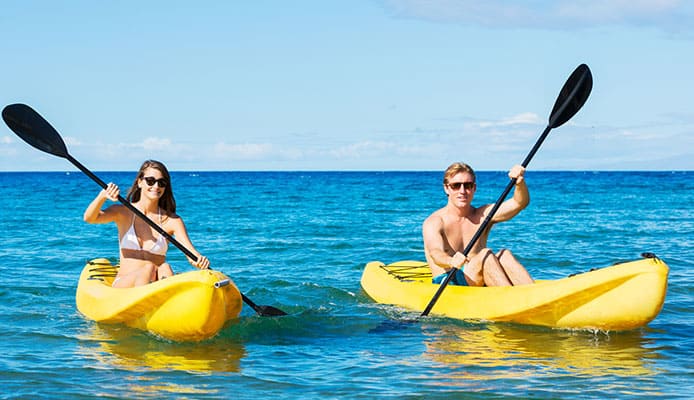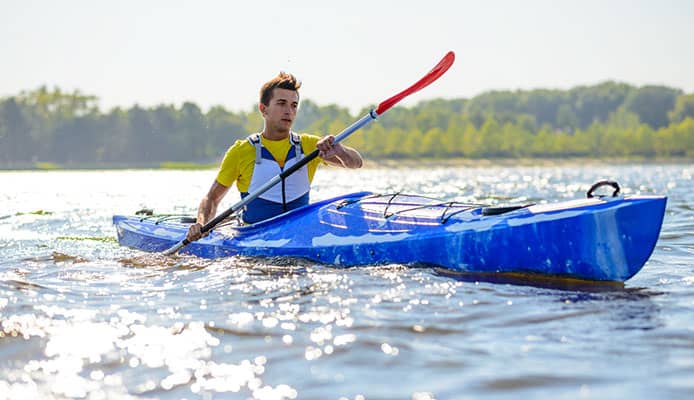
Before going out on the water with your kayak, you need to make sure that you are well equipped for the adventures ahead. If you are kayaking near the shore, then you do not need to pack an extensive list of gear. However, for longer distances, the right gear can be the difference between having an awesome experience of being ill-equipped and miserable.
It’s easy for a kayaker, especially if they are doing this for the first time, to forget which gear kits to bring along. Let’s take a look at 10 of the most essential kayaking essentials to pack when you head out kayaking.
1. The kayak
This might come as a no brainer, but there is more to a kayak than first meets the eye. There are fishing kayaks, ocean kayaks, sit-on-top kayaks, sit-inside kayaks, and slalom boats to mention but a few. These can either be solo lightweight kayaks or tandem kayaks.
If you are a beginner, your go-to choice will likely be the recreational kayak. These are short being only about 4.5 meters long and also feature larger sized cockpits that allow paddlers to easily climb in and out.
These types of kayaks also have a foot pedal that controls the rudder allowing the kayaker to steer in their chosen direction.
Another choice is the sit-on-top kayak. As the name suggests, you will be sited on top of the kayak, and in case you capsize, you don’t have to worry about being trapped as you will simply fall into the water.
2. The Paddle
Unlike canoe paddles that have a single blade on a long shaft, kayak paddles have blades on both ends. They are often between 210cm and 260 cm in length.
For tall individuals, longer paddles are ideal while shorter people will need shorter paddles. Beginners will prefer using plastic paddles. These, however, can break or get lost in the water so it is essential to have an extra paddle if you are planning on taking long-distance trips.
3. Personal floatation device
It really doesn’t, matter if you are a strong swimmer. Sometimes you might hit your head and fall into the water unconscious. Say the kayak came too close to a rocky edge. The PFD will help you float and keep your head above water.
What makes PFDs most suited for kayaking is that they allow for greater arm and neck movement. Choose a PFD that fits you snuggly and is ideal for your type of kayaking. There are PFDs that are better suited for recreational kayaking, whitewater kayaking, touring, or fishing.
If your main objective is fishing on a kayak then you will require some kayak fishing accessories.
4. Helmet
As protection against getting your head bashed by the paddle or the kayak especially when you are riding rapids on a white water kayak, a kayak helmet is among the most important kayaking essentials.
While you will often not find sea kayakers wearing helmets, they are essential for both beginner and experienced kayakers.
When choosing your helmet, the first thing to observe for your kayaking checklist is whether it provides you with sufficient protection on the back of the head, the temple, and the forehead. It should also feature straps to hold it in place and prevent it from slipping back.
You might also like:
Do You Need Kayak Paddle Drip Rings?
5. Wet Shoes
There are two main advantages to wearing wet shoes when kayaking. The first is that they have a rubber sole allowing more grip on slippery surfaces. The second is that they handle the water much better and are fast drying.
And you can forget about wearing flip-flops as these don’t provide nearly as good support for your feet.
Granted there are times where you can spend hours kayaking without getting water on your feet especially if you have a spray skirt. It’s easy to think that you can wear any type of shoe. However, if you do get water on the shoes, they can feel like bricks tied to your feet as they absorb all that water.
Kayak shoes are specifically designed for being in the water. They allow the water to flow easily and coupled with being fast-drying, they are also lightweight and comfortable to wear.
They will also keep your feet safe when getting out of the kayak at the shore. Sharp rocks could cut through the skin if you are not wearing any shoes and the water shoes will provide protection.
6. Wetsuit/Drysuit
Depending on the weather, you can choose to wear a wet suit or a dry suit. The weather is a big influence on water temperatures. If it is too cold then falling in could put you at risk of hypothermia. A wet suit traps a thin layer of warm water close to your body allowing you to maintain the core temperature.
On the other hand, a dry suit locks out all the water. It can be expensive which explains why beginner kayakers prefer the wet suit. You might also need kayaking gloves. If the weather is hot, then you can wear a t-shirt, shorts and a PFD on top.
7. Spray Skirt
As a beginner, you might not think of a spray skirt as an essential part of your kayaking essentials. However, splashing water especially when you are white water kayaking can get into the cockpit.
A spray deck will wrap around your body and the cockpit keeping the water out. This prevents the cockpit from getting too much water and making your sitting uncomfortable.
Spray decks are made from nylon, neoprene, or other waterproof material. Note that if you are using a spray deck, check that the grab loop isn’t inside the kayak. The grab loop should be easy to see on the boat. In case you capsize, you can find it and pull it to pop the deck.
8. Rope Bag
Things can take a drastic turn when kayaking and you might find yourself requiring help or having to help a fellow kayaker. A rope bag contains a rope that is loosely packed inside. Two ends protrude from either side of the rope bag.
This allows you to hold on to one side as you throw the rope bag to another person. A rope bag can be a life-saving piece of gear to take with you when kayaking.
A rope bag should be an important part of your kayaking checklist and it’s important to practice how to use and throw the rope. What you need to keep in mind is to never tie the throw rope around yourself. This will make it easier to let go if need be even if you are in a rescue situation.
9. Paddling knife
A knife might be the last thing you can expect to ever need when you are out kayaking. It’s, however, part of the most versatile and necessary kayaking essentials. And no, we are not talking about the kitchen knife but a handy kayaking knife. They feature a plastic sheath that keeps the blade away from coming into contact with the kayaker’s body.
The kayaking knife should be placed where you can easily and quickly access it in case you need to use it.
Speaking of using the kayaking knife, it can spread peanut butter on bread. What’s more, when white water kayaking will require the use of ropes, a kayaking knife will help cut it to the right proportions. You might also need to free your partner from the entanglement of a strainer.
Also known as paddling knives, they feature a small blade and a small handle. This short profile makes them easy to access and will not get caught up in anything. They, however, will come in different designs so it’s important to get the best one for you.
10. Dry Bag
A dry bag will help you keep your clothes and gadgets dry. They are completely waterproof and are an important piece of gear to carry in any type of water sport. You don’t have to worry about capsizing and losing your clothes and gear in the water.
There are other things that you might want to pack that do not always come to mind. These include duct tape, a multi-tool, some camping gear, a flashlight, sunscreen, fire starter rods, or packed food. This is when the dry bag comes in handy as it not only keeps the water out but also keeps the gear packed together for simple carrying.
Packing extra items in your dry bag when kayaking might make it heavy. You can, however, get around this by planning on what you are going to need. Also, you can choose a dry bag based on the type of kayaking that you plan to have. If it’s wilderness kayaking then you might need a bigger bag to carry more items than if it’s just recreational kayaking.
Globo Surf Overview
There are plenty of other kayak accessories that you might require when kayaking such as a watch, a compass, GPS, or a two-way radio. This kayaking checklist not only gives you the 10 most essential gear to have but also how to carry extra gear in your dry bag. After you’ve made sure to pack all that you need, simply get on your kayak and make the most of your time on the water.
More Kayak Accessories Guides:
- How to Strap a Kayak to a Roof Rack – Easy 5 Step Guide!
- How to Transport And Tie A Kayak Without A Roof Rack
- How to Store a Kayak: Simple Solutions and Quick Tips
- How To Add A Skeg To A Kayak?
- How To Use A Kayak Throw Rope
- A Guide To Kayak Bulkheads
- 11 Steps How to Paint a Kayak & Add Decals
- Kayak Outriggers DIY Guide
- Whitewater Kayaking Gear Guide For Beginners
- Ideas For Kayak Modifications And Upgrades


